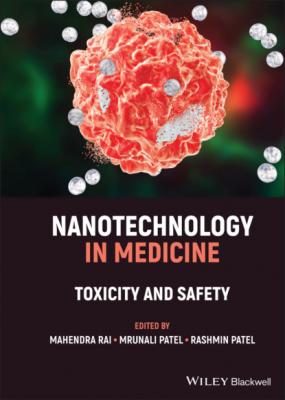Nanotechnology in Medicine. Группа авторов
Чтение книги онлайн.
Читать онлайн книгу Nanotechnology in Medicine - Группа авторов страница 30
 B. (1995). Svedberg – discoverer of the protein macromolecules. Macromolecular Symposia 98 (1): 1227–1245.
B. (1995). Svedberg – discoverer of the protein macromolecules. Macromolecular Symposia 98 (1): 1227–1245.78 Rendón‐Villalobos, R., Ortíz‐Sánchez, A., Tovar‐ Sánchez, E., and Flores‐Huicochea, E. (2016). The role of biopolymers in obtaining environmentally friendly materials. Composites from Renewable and Sustainable Materials https://doi.org/10.5772/65265.
79 Rho, K.S., Jeong, L., Lee, G. et al. (2006). Electrospinning of collagen nanofibers: effects on the behavior of normal human keratinocytes and early‐stage wound healing. Biomaterials 27 (8): 1452–1461. https://doi.org/10.1016/j.biomaterials.2005.08.004.
80 Rhodes, C.J. (2018). Plastic pollution and potential solutions. Science Progress 101: 207–260.
81 Ross, D. (1996). Metabolic basis of benzene toxicity. European Journal of Haematology 60: 111–118.
82 Santos, M.V.C., Tableueiredo, V.O., Arcuri, A.S.A. et al. (2017). Aspectos toxicológicos do benzeno, biomarcadores de exposição e conflitos de interesses. Revista Brasileira de Saúde Ocupacional 42: e13s. https://doi.org/10.1590/2317‐6369nota00017.
83 Selbmann, L., Stingele, F., and Petruccioli, M. (2003). Exopolysaccharide production by filamentous fungi: the example of Botryosphaeria rhodina. Antonie Van Leeuwenhoek 82: 135–145.
84 Sherly, M.C.D., Rekha, M.R., and Harikrishnan, V.S. (2020). Cationised dextran and pullulan modified with diethyl aminoethyl methacrylate for gene delivery in cancer cells. Carbohydrate Polymers 116426 https://doi.org/10.1016/j.carbpol.2020.116426.
85 Shin, S.Y., Park, H.N., Kim, K.H. et al. (2005). Biological evaluation of chitosan nanofiber membrane for guided bone regeneration. Journal of Periodontology 76: 1778–1784. https://doi.org/10.1902/jop.2005.76.10.1778.
86 Silva, I.R., Monteiro, N.K., Martinez, P.F. et al. (2008). Purificação e caracterização de uma gentioexaose obtida de botriosferana por hidrólise ácida parcial. Química Nova 31 (5): 1015–1019. ISSN: 1678‐7064.
87 Singh, S.R., Sainin, G.K., and Kennedy, J.F. (2008). Pullulan: microbial sources, production and applications. Carbohydrate Polymers 73: 515–531.
88 Snyder, R. (2012). Benzene and leukemia. International Journal of Environmental Research and Public Health 9: 2875–2893.
89 Snyder, R. and Hedli, C.C. (1996). An overview of benzene metabolism. Environmental Health Perspectives 104: 1165–1171.
90 Sutherland, I.W. (1998). Novel and established applications of microbial polysaccharides. Trends in Biotechnology 16: 41–46.
91 Tabernero, A., González‐Garcinuño, A., Galán, M.A., and Martín del Valle, E.M. (2019). Microbial exopolisaccharides for biomedical applications. Materials for Biomedical Engineering 12: 165–219.
92 Tao, X., Tao, T., and Wen, Y. (2018). Novel delivery of mitoxantrone with hydrophobically modified pullulan nanoparticles to inhibit bladder cancer cell and the effect of nano‐drug size on inhibition efficiency. Nanoscale Resource Letters 13: 345.
93 Torrecilla, D., Lozano, M.V., Lallana, E. et al. (2013). Anti‐tumor efficacy of chitosan‐g‐poly(ethylene glycol) nanocapsules containing docetaxel: anti‐TMEFF‐2 functionalized nanocapsules vs. non‐functionalized nanocapsules. European Journal of Pharmaceutics and Biopharmaceutics 83: 330–337.
94 Xue, J., He, M., Liu, H. et al. (2014). Drug loaded homogeneous electrospun PCL/gelatin hybrid nanofiber structures for anti‐infective tissue regeneration membranes. Biomaterials 35 (34): 9395–9405. https://doi.org/10.1016/j.biomaterials.2014.07.060.
95 Zayed, M., Tourne‐Peteilh, C., Ramonda, M. et al. (2017). Microgels of silylated HPMC as a multimodal system for drug co‐encapsulation. International Journal of Pharmaceutics 532: 790–801.
96 Zhang, M., Chen, S., Zhong, L. et al. (2019). Zn2+‐loaded TOBC nanofiber‐reinforced biomimetic calcium alginate hydrogel for antibacterial wound dressing. International Journal of Biological Macromolecules https://doi.org/10.1016/j.ijbiomac.2019.12.046.
3 Selenium Nanoparticles: Toxicity and Safety
Irina A. Shurygina, Irina S. Trukhan, Nataliya N. Dremina, and Michael G. Shurygin
Irkutsk Scientific Center of Surgery and Traumatology, Irkutsk, Russia
3.1 Introduction
Today, nanotechnology affects almost all areas of activity, including medicine. NPs are unique, biologically active objects because of their small size, relatively large area, surface modification, as well as presence of surface charges, better solubility, and multifunctionality. Their use allows us to solve many biopharmaceutical and pharmacokinetic problems. NPs often increase the therapeutic efficacy of drugs and improve the solubility of compounds in water. Also, the features of NPs allow them to be used for targeted drug delivery (Chaudhary et al. 2014; Chenthamara et al. 2019; Khan et al. 2020; Shurygina and Shurygin 2020). NPs have unique properties that are not characteristic of substances included in them in a different state (Fadeeva et al. 2015; Shurygina et al. 2016).
A special place among nanotechnologies is occupied by nanocomposites containing essential substances that are part of the mammalian enzyme systems. Often, there is a shortage of these microelements in the environment. An important role among them belongs to Se. This is an essential biologically active microelement and is part of selenoproteins (Khurana et al. 2019). So, as selenocysteine, Se is a part of antioxidant enzymes such as glutadione peroxidase, thioredoxy reductase, and selenoprotein P. In these enzymes, Se acts as a redox center and is necessary to maintain the biochemical activity of the enzymes. Se is also involved in the maintenance of redox homeostasis, inflammatory and immunological reactions by regulating the expression of inflammatory genes at the epigenetic level (Broome et al. 2004). Also, it participates in carbohydrate metabolism, shows a high reactivity to oxidizing agents (Sharifi et al. 2012; Casaril et al. 2017). Se, as a component of enzymes, affects reproductive health and the maintenance of brain function in Alzheimer's disease (Jin et al. 2017). Elemental Se in nanoform has neuroprotective properties (Amani et al. 2019), antitumor activity where SeNPs act as an apoptosis inducer of cancer cells (Sukhov et al. 2017; Trukhan et al. 2018; Xu et al. 2020), and is a highly effective prolonged‐action antioxidant in regenerative medicine (Shurygina and Shurygin 2017, 2018; Tan et al. 2019; Qiao et al. 2020; Bai et al. 2020a).
Se deficiency is associated with numerous human diseases (Vinceti et al. 2017). At the same time, an excess of Se can be toxic and lead to selenosis. Over the past decades, many researchers have identified the significant biomedical potential of SeNPs. However, along with favorable results, it is very important to study the negative and possible side effects associated with the use of Se in nanoforms. NPs are able to enter into the human body by inhalation, oral, parenteral routes and interact with intracellular structures and macromolecules for a long time.